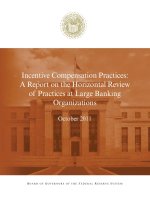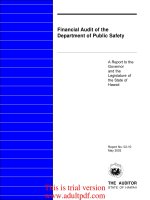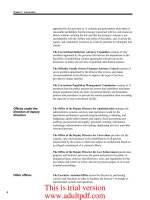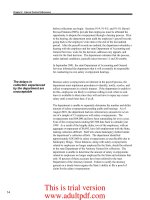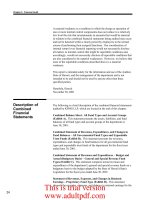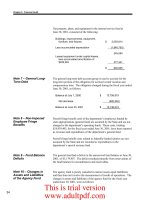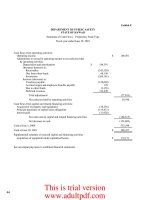Evolution of a Prototype Financial Privacy Notice: A Report on the Form Development Project pptx
Bạn đang xem bản rút gọn của tài liệu. Xem và tải ngay bản đầy đủ của tài liệu tại đây (11.98 MB, 337 trang )
Evolution of a Prototype
Financial Privacy Notice
A Report on the Form Development Project
February 28, 2006
K l e i m a n n C o m m u n i c a t i o n G r o u p , I n c .
Executive Summary
The Financial Modernization Act of 1999, also known as the Gramm-Leach-Bliley Act (GLBA),
requires financial institutions to provide their customers with initial and annual notices of their
privacy policies and practices. The notices must be clear, conspicuous, and accurate
statements of the company’s privacy practices, and provide a means for consumers to opt out
of certain information sharing when they have the right. Soon after the GLBA went into effect
in 2001, researchers reported that the privacy notices were too lengthy, dense in content, and
contained complex language; they found that most consumers neither read nor understand
privacy notices.
In response to these findings, six of the federal agencies
1
that enforce the GLBA initiated a
project to explore the development of paper-based, alternative financial privacy notices—or
components of notices—that are easier for consumers to understand and use. In September
2004, the six agencies selected Kleimann Communication Group (Kleimann) for this project
entitled the Form Development Project.
Our report presents the research-based rationale for a “prototype” privacy notice iteratively
designed over the course of the Form Development Project. The report discusses the
methodology used for our qualitative research; presents our findings and analysis from eight
test sites; describes the evolution of the prototype through a 16-month iterative process; and
outlines key themes that contribute to the success of the project and to the clarity and
usability of the prototype.
This report completes phase one of the Agencies’ two-part research project. Phase two, a
quantitative study to be planned and contracted separately by the Agencies, will assess the
prototype.
1
The six federal agencies are: Board of Governors of the Federal Reserve System, Federal Deposit Insurance
Corporation, Federal Trade Commission, National Credit Union Administration, Office of the Comptroller of
the Currency, and the Securities and Exchange Commission.
Executive Summary i
The Project Objective
The project objective was to explore the reasons why consumers don’t read and understand
privacy notices and to use this research to develop paper-based, alternative privacy notices—
or components of notices—that consumers can understand and use. We used a rigorous,
research-based design model to gather data and make revisions after each iteration based on
consumer input. This process of designing and revising allowed us to continually modify
general and specific features of the prototype, such as content, presentation, and wording.
The process also allowed us to understand barriers to consumer comprehension and
ultimately arrive at a prototype that met the project goals of comprehension, comparability,
and compliance.
The Project Goals
The project had three goals:
Comprehension. The prototype must enable consumers to understand the basic
concepts behind the privacy notices and understand what to do with the notices. It
must be clear and conspicuous as a whole and readily accessible in its parts.
Comparison. The prototype must allow consumers to compare information sharing
practices across financial institutions and to identify the differences in sharing
practices.
Compliance. The content and design of the alternative privacy notices must include
the elements required by the GLBA and the affiliate marketing provision of the Fair
and Accurate Credit Transactions Act.
Design Considerations
Within the design, we worked with several considerations and constraints:
Neutral and Objective. The prototype needed to inform consumers about privacy
laws and financial institutions’ sharing practices in a factual and neutral way. The
language could and should not direct a consumer to make any particular decision.
Through the course of designing and testing, we stayed away from using
inflammatory or potentially provocative words as a means of attracting attention.
Format and Design. The prototype must be paper-based rather than Web-based. To
focus on the research goals of comprehension, comparability, and compliance and
minimize testing variables, we tested only in black and white, on 8½” x 11” paper, and
with a large, readable font.
Executive Summary ii
Methodology
We used a varied, qualitative research-based design process to accomplish the project
objective and goals. The financial privacy notice prototype evolved in content and design
based on an iterative process of consumer research, rigorous data collection, thorough
analysis, and the expertise of the information designers and legal experts.
Qualitative research uses small numbers of participants to explore in a realistic manner how
and why consumers understand and make sense of a document. For the Form Development
Project, we used four qualitative methods
2
—focus groups, preference testing, pretest, and
diagnostic usability testing—to iteratively develop and refine the prototype according to the
goals of comprehension, comparability, and compliance.
Testing
We tested a total of 66 participants over eight test rounds in various locations based on the
U.S. census regions and divisions. The testing was conducted over 12 months, as follows:
Two focus groups with 10 participants in each, 20 participants total (Baltimore, MD)
Preference testing with 7 participants (Washington, DC)
Pretest with 4 participants (Baltimore, MD)
Diagnostic usability testing with 35 participants in five sites (San Francisco, CA;
Richmond, VA; Austin, TX; Boston, MA; and St. Louis, MO)
2
Focus groups and preference testing provide baseline information on consumers’ impressions, attitudes,
likes and dislikes about the subject matter and the initial documents. Focus groups tell the researcher what a
group of consumers thinks about privacy notices and what they see as barriers to understanding them, but
they do not tell the researcher what a consumer will actually do with a notice. Preference testing uses in-
depth one-on-one interviews that explore consumers’ preferences for certain vocabulary, headings, notice
components, and ordering of the information. This testing informs the initial document designs. Conducting
a pretest allows for a dry run of the diagnostic usability test, and validates the methodology by testing the
moderator’s guide and test design. Diagnostic usability testing looks at how the individual participant
actually works with a document and elicits his or her immediate reaction to the information content and
design to target and diagnose problems. This testing approach allows for more in-depth probing of
consumers’ attitudes toward the document and, because it is an iterative process, also allows for continual
adjustment to the notice content and design with successive test rounds.
Executive Summary iii
Research and Design
Each test session was carefully planned and structured to meet our research goals of
comprehension, comparison, and compliance. The following five questions helped guide the
development of the prototype content and design. How do we:
1. attract consumers’ attention to the notice using only objective and factual language;
2. decide what information to include;
3. ensure that consumers can understand about the sharing of their personal
information;
4. ensure that consumers can compare sharing practices across financial institutions; and
5. enable consumers to understand how to opt out.
Prototype Evolution
As with most design development projects, one key challenge was how to select and organize
the content of the notice to address these goals and questions. We used the information and
elements required by the law, organizing them in different ways throughout the process to
arrive at a final organization of the content that worked.
We developed and tested a variety of designs, ultimately structuring the disclosure of
information sharing practices in a table format. We learned that we needed to include an
educational component in the notice as consumers had no prior understanding of information
sharing practices. To do this, we identified the key information that would draw the reader
into the notice and provide sufficient information to enable understanding of the disclosure
table. Supplemental information, such as definitions and additional information required by
the GLBA, was provided on page 2 of the prototype. Testing showed that consumers could
work with page 1 alone, although they appreciated the supplemental information on page 2
for further clarification. We also experimented with a prose design of the disclosure
information, but the table design worked far better in helping consumers easily access,
understand, and compare sharing practices.
The Prototype Notice
The prototype
3
has four key components—the title, the frame (key and secondary), the
disclosure table, and the opt-out form—that contribute in multiple ways to its effectiveness.
3
The prototype is intended to be used by any financial institution, but for convenience, we used fictional
bank names for the notices.
Executive Summary iv
The Title
The title helps consumers understand that the notice is from their bank and that their personal
information is currently being collected and used by their bank.
The Frame
The frame is at the heart of ensuring comprehension because it provides basic information
about financial sharing practices as a context for consumers to understand the details of their
particular bank’s sharing practices. The key frame on page 1 provides a context for the
consumer and gives key details. The secondary frame on page 2 also includes a series of
frequently asked questions, more required information, and more detailed definitions of terms
on page 1. The frame is necessary for understanding the disclosure.
The Disclosure Table
The disclosure table is at the heart of the prototype. It not only shows what the individual
financial institution is sharing, but also includes seven basic reasons any financial institution
can share information. The disclosure table, therefore, enables consumers to understand the
details of their financial institution’s sharing practices in the context of how other financial
institutions can share. It is critical for comprehension and comparability.
The Opt-out Form
The opt-out form identifies how a particular financial institution allows consumers to limit a
particular type of sharing.
Executive Summary v
Title
Draws
consumers into
the notice,
helping them
understand
that the
information in
the prototype
is from their
own financial
institution and
that their
personal
information is
being collected
and used by
the financial
institution.
Page 1
Executive Summary vi
Key Frame
Provides a
context for the
consumer and
gives key details
about personal
information,
information
sharing
practices, and
the laws relating
to these
practices. It is
the heart of
ensuring
comprehension.
Page 1
Executive Summary vii
Disclosure
Table
Shows seven
basic reasons a
financial
institution can
share, indicates
how this bank
shares, and
identifies
whether the
consumer can or
cannot opt out.
Because the
disclosure table
shows both
what any
institution can
do and what an
individual
institution does,
it allows
consumers to
compare across
institutions.
Page 1
Executive Summary viii
Secondary
Frame
Provides a
series of
frequently
asked
questions, more
legally required
information,
and more
detailed
definitions of
the terms on
page 1.
Together with
the information
on page 1 and
the opt-out
form, it
addresses all
the elements
required by
GLBA.
Page 2
Executive Summary ix
Opt-out
Form
Identifies
how a
particular
financial
institution
allows
consumers
to opt out of
a particular
kind of
sharing if the
institution’s
sharing
triggers an
opt-out. It is
intentionally
on a separate
page as
consumers
suggested.
Page 3
Meta-themes
Six meta-themes informed and guided the development of the prototype. To an extent, these
meta-themes are universal design principles. The tendency in the design development of a
complex product is to say too much, to let design decorate, to attract attention at the expense
of balance, to provide the specifics without a context, and to standardize without
discrimination. The final prototype—our design and content decisions—grows out of and is
grounded in these themes, our particular research methodology, and our research results.
Keep it simple. Our research consistently showed that consumers are overwhelmed by too
many words, complex information, and vague words and phrases. In fact, when faced with
complex information, they often won’t even bother to read. Our evolution of the prototype
focused on minimizing burden on the consumer by continually simplifying the notice. We
stripped away redundancies, reduced words, used simpler words, clarified meaning, and
provided key context information up front. At the same time, we did not oversimplify. A notice
that strips away all contextual information will be short, but uninformative. The challenge is to
Executive Summary x
find the balance between as few words as possible and enough information so consumers
understand.
Good design matters. Good design delivers important information in a format that reinforces
the content. Our research repeatedly showed that consumers responded positively to the
table design, headings, white space, bold text, bulleted lists, a larger font size, and full-size
paper. These design techniques, combined with the simplified content, helped consumers
better understand the information. They recognized that it looked different from other privacy
notices, commenting that it was easier to read and that it looked more inviting. The easy-to-
read design created the impression that the bank wanted the information to be read and
understood.
Careful design decisions ensure neutrality. The point of privacy notices is to provide
information, not direct a decision. They need to deliver information about financial sharing
practices in a way that reports the information truthfully. We, therefore, focused on using
factual language, objective presentation, and non-inflammatory words. In each round of
testing, we listened for comments, reactions, and perceptions from consumers that indicated
areas of potential bias in the notice. The iterative testing process allowed us to make design
decisions that led to a final notice that is intended to be clear, neutral, and unbiased.
A “whole-to-part” design is critical to comprehension. Our research showed that
consumers needed a context for understanding the information in the notice. Most consumers
do not have an operational understanding of information sharing. Therefore, the notice
needed to provide enough context that consumers could understand the detail both at the
general level and at the table level.
The key frame component provides a context about financial sharing laws and personal
information so consumers can understand the disclosure table.
The disclosure table frames the bank’s sharing practices by giving reasons financial institutions
can share information. Consumers can then distinguish and understand the specific sharing
practices of their bank and compare them to other institutions.
Consumers need the context of both the whole and part to understand the critical details.
Without context, they understand virtually nothing.
Standardization is highly effective. Standardization of form and content helped consumers
recognize the notice and the information in it. As they became familiar with the prototype,
they learned where to look for the differences. Standardization reduces cognitive burden
because consumers recognize the information without having to continually re-read notices
word for word.
Executive Summary xi
The disclosure table is critical. The disclosure table is at the heart of the prototype. It shows
consumers how their personal information might be shared, how their particular bank shares
it, and what sharing they can limit. Simple, concise, and highly visual, the standardized
disclosure table simplifies highly complex and mandatory information into a design that
consumers can understand without undue burden. Our research showed that consumers
preferred the standardized disclosure table, could understand the disclosure information with
greater ease than with the prose design, and could compare accurately sharing practices
across financial institutions. The disclosure table, with its whole-to-part structure, is critical to
consumer understanding and comparing financial sharing practices.
Ultimately, the prototype derived from eight rounds of testing ensures that the information
about financial privacy laws and sharing practices is available to the public in a clear and
understandable notice. This report extensively details the evolution of the prototype through
each of the test rounds, illustrating how the prototype and its components clearly and
conspicuously inform consumers, who can, therefore, make informed choices. That was the
crux of the Form Development Project—and its success.
Executive Summary xii
Table of Contents
Executive Summary i
The Project Objectives ii
The Project Goals ii
Design Considerations ii
Methodology iii
Testing iii
Research and Design iv
Prototype Evolution iv
The Prototype Notice iv
Meta-themes x
Chapter 1. Introduction 1
What Were the Objective and Primary Goals of the Form Development Project? 2
How Should You Read This Report? 3
Chapter 2. What Does the Final Prototype Look Like? 5
The Title 6
The Frame 6
The Disclosure Table 7
The Opt-out Form 7
The Final Prototype 8
Chapter 3. Research Methodology 13
What is the Information Design Model? 13
What is Qualitative Testing? 14
Where Did We Test? 17
How Did the Prototype Evolve with Testing? 17
How Did We Analyze? 20
Conclusion 22
Chapter 4: Focus Groups—Baltimore, Maryland 25
Research Goals 25
Notices Tested 26
Table of Contents xiii
Major Findings 33
RQ 1: What are participants’ attitudes and general level of knowledge about privacy
notices before looking at the initial designs? 33
RQ 2: What are participants’ suggestions and perceptions when they view the initial
designs? 35
Content Suggestions 35
Design Suggestions 37
Participant Perceptions 40
Focus Group Conclusion 43
Revisions to the Initial Designs 45
Chapter 5: Preference Testing—Washington, DC 47
Research Goals 47
Notices Tested 47
Major Findings 63
Language/Word Choice 63
Titles 66
Information Sharing 67
Opt-out Form 68
Fact Sheet 69
Ordering Information 69
Preference Testing Conclusion 71
Revisions to the Initial Designs 73
Chapter 6: Pretest—Baltimore, Maryland 75
Research Goals 75
Notices Tested 75
Major Findings 101
RQ 1: Do participants understand the purpose? 101
RQ 2: Do participants understand the content? 102
RQ 3: Do participants understand there are action items? 102
Overall Research Question: Which design better aids participants’ comprehension
and comparison of sharing practices? 103
Pretest Wrap-up 105
Revisions to the Initial Designs 107
Table of Contents xiv
Chapter 7: Diagnostic Usability Testing—San Francisco, California 109
Research Goals 109
Notices Tested 110
Major Findings 119
RQ 1: Do participants understand the added context? 119
RQ 2: Do participants understand the purpose and the main points? 120
Content Understanding 120
Design Preferences 123
Word Choice Preferences 124
RQ 3: Do participants understand the differences in sharing practices? 127
Content Understanding 127
Design Preferences 128
Participant Perceptions 129
San Francisco Conclusion 131
Revisions to the Draft Prototype 133
Chapter 8: Diagnostic Usability Testing—Richmond, Virginia 137
Research Goals 137
Notices Tested 138
Major Findings 147
RQ 1: Do participants understand the added context? 147
RQ 2: Do participants understand the purpose and the main points? 149
Content Understanding 149
Design Preferences 151
Word Choice Preferences 153
RQ 3: Do participants understand the differences in sharing practices? 155
Content Understanding 155
Design Preferences 156
Participant Perceptions 157
Richmond Conclusion 161
Revisions to the Draft Prototype 163
Chapter 9: Diagnostic Usability Testing—Austin, Texas 165
Research Goals 165
Notices Tested 166
Table of Contents xv
Major Findings 181
RQ1: Do participants understand the added context? 181
RQ 2: Do participants understand the purpose and the main points? 182
Content Understanding 182
Design Preferences 184
Word Choice Preferences 186
RQ 3: Do participants understand the differences in sharing practices? 188
Content Understanding 188
Participant Perceptions 189
Austin Conclusion 193
Revisions to the Draft Prototype 195
Chapter 10: Diagnostic Usability Testing—Boston, Massachusetts 197
Research Goals 197
Notices Tested 198
Major Findings 213
RQ1: Do participants understand the added context? 213
RQ 2: Do participants understand the purpose and main points? 214
Content Understanding 214
Design Preferences 215
Word Choice Preferences 216
RQ 3: Do participants understand the differences in sharing practices? 218
Content Understanding 218
Design Preferences 218
Participant Perceptions 219
Boston Conclusion 223
Revisions to the Draft Prototype 225
Chapter 11: Diagnostic Usability—St. Louis, Missouri 227
Research Goals 227
Notices Tested 228
Major Findings 253
RQ 1: Do participants understand the added context? 253
RQ 2: Do participants understand the purpose and main points? 255
Content Understanding 255
Design Preferences 256
Word Choice Preferences 258
Table of Contents xvi
RQ 3: Do participants understand the differences in sharing practices? 258
Content Understanding 259
Design Preferences 260
Participant Perceptions 261
St. Louis Conclusion 265
Revisions to the Draft Prototype 267
Chapter 12. Conclusions 269
Meta-themes 272
Appendices
Appendix A: Final Prototypes
Appendix B: Demographics
Appendix C: Rotations and Structure of Testings
Table of Contents xvii
Chapter 1. Introduction
“In the 21
st
century, personal information is
one of the most important assets you have.”
1
The Financial Modernization Act of 1999, also known as the Gramm-Leach-Bliley Act (GLBA),
requires financial institutions to provide their customers with initial and annual notices of their
financial privacy policies and practices. The GLBA requires that the financial privacy notices be
a clear, conspicuous, and accurate statement of a company’s privacy practices,
2
provide a
means for consumers to opt out of certain information sharing when they have the right, and
describe how a financial institution collects, shares, and protects consumers’ personal
information.
In their attempts to adhere to the requirements of the GLBA, many financial institutions have
tended to create privacy notices that are long and complex. Moreover, studies conducted
since the implementation of the GLBA show that most consumers neither read the financial
privacy policies nor understand the issues involved.
3
This outcome is in direct contrast to the
government’s intention behind regulating financial institutions’ disclosure of their financial
sharing practices to consumers—that is, to build consumers’ comprehension and their ability
to compare financial sharing practices.
In a continued effort to educate consumers about financial institutions’ specific financial
sharing policies and practices, six of the federal agencies that enforce the GLBA initiated a
project to develop paper-based, alternative financial privacy notices—or components of
notices—that are easier for consumers to understand and use. The sponsoring agencies
included the following:
Board of Governors of Federal Reserve System (Board)
Federal Deposit Insurance Corporation (FDIC)
Federal Trade Commission (FTC)
National Credit Union Administration (NCUA)
1
California participant 106.
2
Federal Trade Commission—Facts for Businesses. In brief: The financial privacy requirements of the Gramm-
Leach-Bliley Act. Retrieved November 21, 2005, from
3
For example, see Turow, J. (2003). Americans and online privacy: The system is broken. A Report from the
Annenberg Public Policy Center at the University of Pennsylvania, June 2003.
Chapter 1 1
Office of the Comptroller of the Currency (OCC)
Securities and Exchange Commission (SEC).
In August 2004, the sponsoring agencies circulated a Request for Proposal (RFP) for a Form
Development Project
4
to (1) explore the reasons why consumers don’t read and understand
privacy notices, and (2) develop alternative notices or components of notices that are easier
for consumers to understand and use.
In September 2004, the FTC, on behalf of the six agencies, awarded the contract to Kleimann
Communication Group, Inc. (Kleimann) under the General Services Administration’s Mission
Oriented Business Integrated Services (MOBIS) program. Kleimann started the Form
Development Project in October 2004 and completed the project in February 2006.
What Were the Objective and Primary Goals of the Form
Development Project?
The objective of the Form Development Project was to develop paper-based alternative
privacy notices that consumers can understand and use. More specifically, the main goals of
this project were the following:
Comprehension. The alternative privacy notices must enable consumers to
understand the basic concepts behind the privacy notices and understand what to do
with them. The notices must be clear and conspicuous as a whole, and each part must
be readily accessible.
Comparison. The alternative privacy notices must allow consumers to compare
information sharing practices across financial institutions and to identify the
differences in sharing practices.
Compliance: The alternative privacy notices must include the elements required by
the GLBA and the affiliate marketing provision of the Fair and Accurate Credit
Transactions Act (FACT Act).
4
The Form Development Project is Phase 1 of a two-part research project planned by the Agencies. Phase 2 is
a quantitative study, which will evaluate and validate the results of this project and will be contracted out
separately.
Chapter 1 2
How Should You Read This Report?
In this report, we present a research-based rationale for the evolution of the alternative
privacy notices into what we refer to as the final prototype. We present the final prototype and
identify its key components: the title, the frame (key and secondary), the disclosure table, and
the opt-out form. Because we collected information from consumers using focus groups and
other methodologies, we provide the details about the complex and varied testing
methodology used to create the final prototype. Conducted over16 months, the eight rounds
of consumer testing generated a rich array of detailed findings and data. In this report, we
discuss each round of testing and how the prototype’s content and design evolved in
response to the iterative consumer testing. For each discussion, we provide the draft notices
that we tested.
This report is organized into twelve chapters and three appendices.
Chapter 2. What does the final prototype look like? presents the prototype and
identifies the key components of the prototype: title, frame (key and secondary),
disclosure table, and opt-out form.
Chapter 3. Research Methodology describes the design and testing process. It
specifies the who, what, and how of the testing methodology and gives an overall
timeline and “map” of how we designed, tested, and integrated testing results.
Chapter 4. Focus Groups in Baltimore, Maryland discusses the baseline information
we collected in two focus groups. These results produced the first versions of the
prototype.
Chapter 5. Preference Testing in Washington, DC reports the results of a series of
interviews in which we asked consumers about language, titles, and ordering.
Chapter 6. Pretest in Baltimore, Maryland discusses the failures of the initial designs
with consumers and the importance of providing sufficient context for them to
understand the disclosure information.
Chapter 7. Diagnostic Usability Testing in San Francisco, California discusses the
first workable version of the prototype and the consumer issues that arose as
consumers compared sharing practices using the prototype.
Chapter 8. Diagnostic Usability Testing in Richmond, Virginia discusses the further
validation of the prototype used in San Francisco and suggestions for additional
changes to the prototype. We also identify emerging consumer issues.
Chapter 1 3
Chapter 9. Diagnostic Usability Testing in Austin, Texas discusses the results of the
consumer testing and the use of a prose version of the disclosure. We continue to
identify consumer issues.
Chapter 10. Diagnostic Usability Testing in Boston, Massachusetts discusses the
results of the consumer testing, the use of a prose version of the disclosure, and a
possible one-page version of the prototype. We continue to identify consumer issues.
Chapter 11. Diagnostic Usability Testing in St. Louis, Missouri discusses the results
of the consumer testing and the final evolution of the prototype. We continue to
identify consumer issues.
Chapter 12. Conclusion synthesizes findings into meta-themes that informed the
development of the prototype.
Appendix A provides copies of the final tab le and prose versions of the prototype.
Appendix B provides the demographics of participants for each round of testing.
Appendix C details the sequence in which participants examined the notices.
Chapter 1 4
Chapter 2. What Does the Final Prototype
Look Like?
The goals of the Form Development Project were clear from the start—comprehension,
comparison, and compliance. To guide us through the development of the content and
design, we used the following five key questions:
1. How do we attract consumers’ attention using only objective and factual language so
that they will read?
2. How do we decide what information to include?
3. How do we ensure that consumers can understand the information about financial
sharing policies and their personal information?
4. How do we ensure that consumers can compare sharing practices across financial
institutions?
5. How do we enable consumers to understand how to opt out?
The actual decisions of how to select and then organize the content to address these
questions were far less clear. Through the course of the design and testing, we were cognizant
of the importance of developing a neutral notice—a notice that objectively presents the
information GLBA requires and does not itself seek to direct the consumer’s behavior. As a
result, we avoided using “marketing” techniques. We chose to present information objectively
and factually. We stayed away from inflammatory and provocative words and phrases to
attract attention. We also neutralized many of the design elements so that participants
focused on content. We controlled testing variables: we did not use color; we used a readable
and large font; and we used 8.5” x 11” paper. We used information and elements included in
GLBA, organizing them in different ways throughout the testing process to arrive at a final
organization and content that worked.
In pursuing our original goal of creating alternative notices and components, we ultimately
created a prototype comprising four components: a title, a frame (key and secondary), a
disclosure table, and an opt-out form on a separate page.
On the next pages, we present the prototype and identify each component. The prototype
uses a fictional bank name and shows the maximum sharing allowed by law. As we developed
the prototype, we used other fictional bank names and showed other levels of sharing. The
Chapter 2 5
